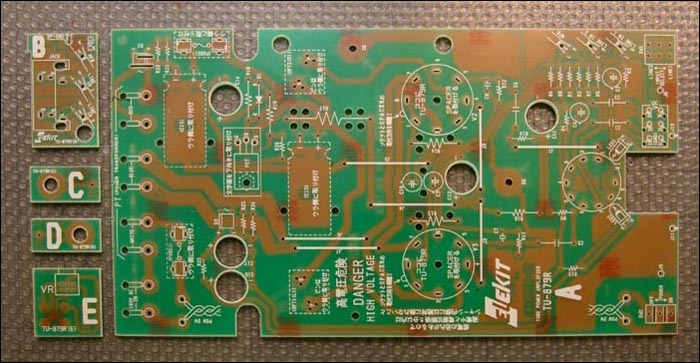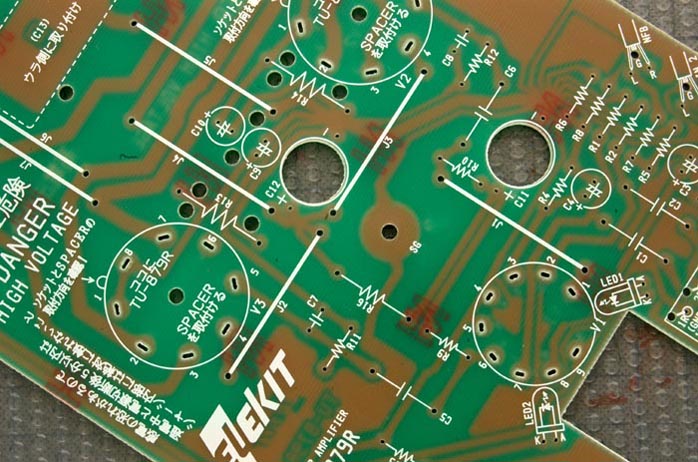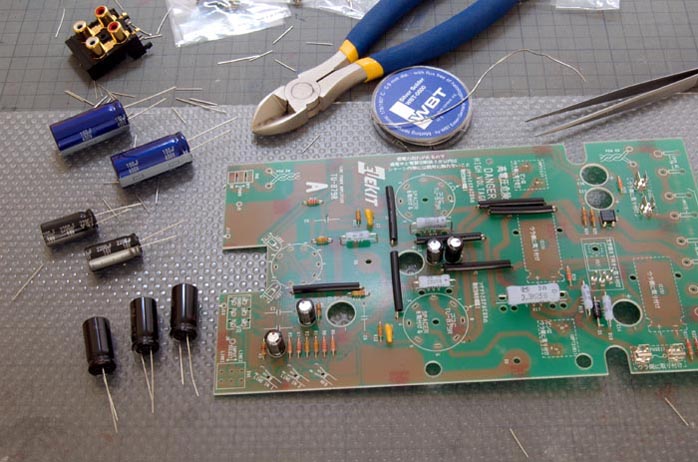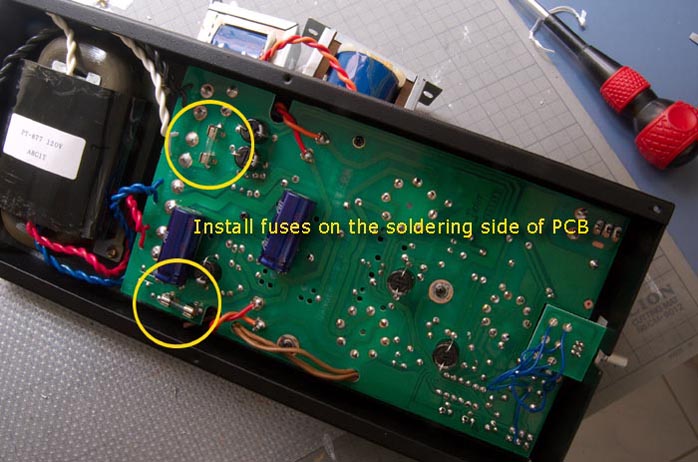|
This review page is supported in part by the sponsors whose ad banners are displayed below
|
|||||||||||||||
 |
|||||||||||||||
| The two output transformers labelled OPT879 are made by Giken to Elekit's specifications of a 5K internal impedance into a 4 to 8-ohm load. The volume attenuator is a 41-step Alps RK0971210D97 rated at 100K with a type B taper. A type A taper sports a 'concave' value/rotation index whereby volume increases at logarithmic increments toward the end of the rotation whereas a type C is the opposite with an inverse 'convex' curve. Type B is a straight line. I personally prefer B for its predictable linear behaviour (and most stepped VRs are type B anyway). However, from what I've encountered, stepless type As seems to be the favored choice of most manufacturers for more gradual increments over the first 90 degrees of their knob's turn. But the Elekit pot is far from abrupt. It actually gives a good sense of proportion to its step-by-step increments. Throughout my audition, I never encountered an incidence with any recorded music where a one-step adjustment was too loud or not loud enough. On its scale of 40 clicks that starts at 7 o'clock minimum to 5 o'clock max, my 95.5dB Klipsch Synergy F2 at 10:00 (or the 12th click to be precise) reached just about my usual comfortable listening levels. I assume that roughly equates to somewhere between 12:00 an 1:00 for most low-power amps with type A potentiometer. It isn't really cheating but does give the impression that this amp is really potent. It indeed is as we'll find out. |
|||||||||||||||
|
| |||||||||||||||
Wide choice of speakers Let's begin with the stock bottles and a single stereo amp. As I said, the new pair of 6L6EHs initially was a little bright. Perhaps they and the amp needed time to mellow out. After about 50 hours, things became more palatable. During that time, I tried out the new giant killer Mark & Daniel Maximus-Diamond + , the equally inefficient 84dB/4ohm Dynaudio Facette and the 89dB/8-4ohm JMlab Micron. None of them put the TU-879S to shame. To be fair, you don't normally pair up low-power tube amps with such speakers except for the Micron, which is a plausible choice. If the richness in bass and warmth of timbre were surprisingly good with the Micron, the equally good or better sonics achieved with the Facette were unthinkable knowing that my 'official' amp for this speaker is the NuForce Ref 9 SE V2. The Diamond+ was another exercise in disbelief. How on earth could I expect this speaker to deliver such clean punchy bass and holographic resolution from eight tiny watts per channel until I verified it with my own ears? Did I have to crank up the volume on the TU-879S to do so? Nope. I only had to creep to 12:00, from 10-ish for the Micron to 11-ish for the Facette. That's mild. Granted, I did not send in my heavy orchestral infantry but piano and chamber works which occasionally fired up emotionally charged passages still were quite challenging. |
|||||||||||||||
 |
|||||||||||||||
|
This image opens to 2000 x 979 at 318KB in a new window
|
|||||||||||||||
| From my meager stable of high-efficiency speaker, the Loth-X BS-1 was decent but didn't bring out as much valve magic as I hoped. The Klipsch F2 proved to be a better match with its deeper bass and warmer mids. In fact, I become more and more convinced that the F2 is the best value and partner for-low power tube and Tripath amps. Some readers challenge my lone praise for this speaker when everyone else on the net has dumped on it. Curiosity drove me to research this discrepancy and I came across a forum (a certain speaker manufacturer's fan club) where everyone claimed how the F2 was simply no comparison to the speaker of their choice, 'too bright' being the main complaint. I am not here to defend anything or insult anyone's intelligence. I did notice however that the members of this group used home theater receivers. I suppose that might have weighted the outcome. Anyway, my significant half grew so fond of the sound that I won her eventual blessing to acquire three more F2 (one cherry, two black ash) to complete my all tube, all Klipsch 5-channel audio system. |
|||||||||||||||
 |
|||||||||||||||
The power of music Back to 2-channel for now. The Elekit TU-879S and Klipsch F2 synergy invoked the magical power of setting my mind on music more than anything. I found myself being constantly drawn into a relaxed mood of enjoyment rather than pointing my ears radar-like to chase sonic attributes. This was partly due to the music of course. Gergely Bogányi's inspired reading of Chopin's Complete Nocturnes [Stockfisch SFR 357.4051.2] has renewed my admiration for these masterpieces. This is the double SACD album that won over my wife. The young Hungarian pianist doesn't shy away from an interpreter's liberties, unearthing the innermost sentiments of each piece as if one heard them for the first time. His daringly imaginative rubato and lyricism aren't just captivating but convincing, at least for us. (If you have a weak stomach for broken rules, keep away. Some online reviewers disagree with his 'wavering' approach.) The instrument is a Fazioli F 308 vividly captured on 2-channel direct-cut SACD (DSD domain throughout the entire process) with a downward compatible PCM layer for ordinary Redbook players. |
|||||||||||||||
 |
|||||||||||||||
The young British violinist Chloë Hanslip hypnotized me with her dazzling virtuosity and musical eloquence on her splendid collaborated with young German pianist Caspar Frantz in the rare compilation of Works for Violin and Piano by Antonio Bazzini [Naxos 8.570800], whose reputation and creative spectrum have been unfairly misrepresented by the ever popular virtuoso La Ronde des Lutins. Listen to his Trois morceaux lyriques, Le Départ and Le Retour. You'll understand that he possessed more depth than sheer flamboyance and was a soulful composer who eventually became the director of the Milan Conservatory and teacher of Mascagni and Puccini. |
|||||||||||||||
 |
|||||||||||||||
Another rare find occurred in the guitar repertoire. Spanish guitarist Agustin Maruri's Spanish Romance [EMEC E-049] is an anthology of 19th century Spanish guitar music. Most of the works here are exclusive recordings from the original scores discovered by Maruri. Don't be thwarted by the unfamiliar names of composers like Antonio Giménez Manjón, Juan Parga, Antonio Cano and Cristobal Oudrid. Their Romanza, Mazurka, Habenera and Tango will soon melt your heart or set your foot tapping. Maruri performs on two rare 19th century instruments from the New York Metropolitan Museum of Art. |
|||||||||||||||
 |
|||||||||||||||
Michael Kevin Jones' Bach Cello Suites [EMEC E-056/7] is a must-have version no matter how many other recordings you have of this immortal work. First, the British cellist performed on a 1667 Stradivarius cello, one of the oldest celli 'alive' from the Metropolitan Museum of Art's collection. Considering that Bach was born in 1685 when the viola da gamba still enjoyed much in favor among composers, it's a priceless experience to hear this for the times "revolutionary" instrument. It does sound very much like a viol. But that's not the only special element of this recording. Jones' authentic approach to the Baroque dance form comes as a true revelation. His elegant yet spirited phrasing frees the pulse and rhythm which has nothing to do with tempo. In fact, Yo-Yo Ma and Starker in most cases chose faster tempi. Jones is British and has teamed up with Maruri in a cello-guitar duo since 1990. They will be touring China again this December for nine concerts. |
|||||||||||||||
 |
|||||||||||||||
Soprano Ljuba Kazarnovskaya's final installment of Tchaikovsky's Complete Songs, Vol. 5 [Naxos 8.570438] presents us with the fruitful potpourri of heartbreaking love songs and operatic drama. With her wide tonal spectrum (some Tchaikovsky songs are performed by mezzo-soprano) and naturally rich timbre, Kazanovskaya probes into the emotive corners and the melodic spontaneity of the Russian master. Superb piano accompaniment from Ljuba Orfenova further bears witness to Tchaikovsky's pianistic lyricism. |
|||||||||||||||
|
| |||||||||||||||
 |
 |
||||||||||||||
 |
|||||||||||||||